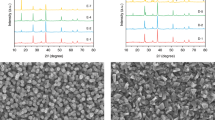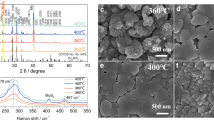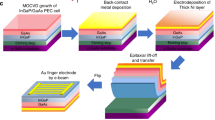Abstract
Although large research efforts have been devoted to photoelectrochemical (PEC) water splitting in the past several decades, the lack of efficient, stable and Earth-abundant photoelectrodes remains a bottleneck for practical application. Here, we report a photocathode with a coaxial nanowire structure implementing a Cu2O/Ga2O3-buried p–n junction that achieves efficient light harvesting across the whole visible region to over 600 nm, reaching an external quantum yield for hydrogen generation close to 80%. With a photocurrent onset over +1 V against the reversible hydrogen electrode and a photocurrent density of ~10 mA cm−2 at 0 V versus the reversible hydrogen electrode, our electrode constitutes the best oxide photocathode for catalytic generation of hydrogen from sunlight known today. Conformal coating via atomic-layer deposition of a TiO2 protection layer enables stable operation exceeding 100 h. Using NiMo as the hydrogen evolution catalyst, an all Earth-abundant Cu2O photocathode was achieved with stable operation in a weak alkaline electrolyte. To show the practical impact of this photocathode, we constructed an all-oxide unassisted solar water splitting tandem device using state-of-the-art BiVO4 as the photoanode, achieving ~3% solar-to-hydrogen conversion efficiency.
This is a preview of subscription content, access via your institution
Access options
Access Nature and 54 other Nature Portfolio journals
Get Nature+, our best-value online-access subscription
$29.99 / 30 days
cancel any time
Subscribe to this journal
Receive 12 digital issues and online access to articles
$119.00 per year
only $9.92 per issue
Buy this article
- Purchase on Springer Link
- Instant access to full article PDF
Prices may be subject to local taxes which are calculated during checkout






Similar content being viewed by others
References
Luo, J. Water photolysis at 12.3% efficiency via perovskite photovoltaics and Earth-abundant catalysts. Science 345, 1593–1597 (2015).
Walter, M. G. et al. Solar water splitting cells. Chem. Rev. 110, 6446–6473 (2010).
Ager, J. W., Shaner, M. R., Walczak, K. A., Sharp, I. D. & Ardo, S. Experimental demonstrations of spontaneous, solar-driven photoelectrochemical water splitting. Energy Environ. Sci. 8, 2811–2824 (2015).
Osterloh, F. E. Inorganic nanostructures for photoelectrochemical and photocatalytic water splitting. Chem. Soc. Rev. 42, 2294–2320 (2013).
Sivula, K. & van de krol, R. Semiconducting materials for photoelectrochemical energy conversion. Nat. Rev. Mater. 1, 15010 (2016).
Paracchino, A., Laporte, V., Sivula, K., Grätzel, M. & Thimsen, E. Highly active oxide photocathode for photoelectrochemical water reduction. Nat. Mater. 10, 456–461 (2011).
Tilley, S. D., Schreier, M., Azevedo, J., Stefik, M. & Grätzel, M. Ruthenium oxide hydrogen evolution catalysis on composite cuprous oxide water splitting photocathodes. Adv. Funct. Mater. 24, 303–311 (2014).
Luo, J. et al. Cu2O nanowire photocathodes for efficient and durable solar water splitting. Nano Lett. 16, 1848–1857 (2016).
Minami, T., Nishi, Y. & Miyata, T. Effect of the thin Ga2O3 layer in n+-ZnO/n-Ga2O3/p-Cu2O heterojunction solar cells. Thin Solid Films 549, 65–69 (2013).
Minami, T., Nishi, Y. & Miyata, T. High-efficiency Cu2O-based heterojunction solar cells fabricated using a Ga2O3 thin film as n-type layer. Appl. Phys. Express 6, 44101 (2013).
Lee, Y. S. et al. Atomic layer deposited gallium oxide buffer layer enables 1.2 v open-circuit voltage in cuprous oxide solar cells. Adv. Mater. 26, 4704–4710 (2014).
Li, C. et al. Positive onset potential and stability of Cu2O-based photocathodes in water splitting by atomic layer deposition of a Ga2O3 buffer layer. Energy Environ. Sci. 8, 1493–1500 (2015).
Jiang, T. et al. Copper borate as a photocathode in p-type dye-sensitized solar cells. RSC Adv. 6, 1549–1553 (2016).
Ito, T. & Masumi, T. Detailed examination of relaxation processes of excitons in photoluminescence spectra of Cu2O. J. Phys. Soc. Jpn. 66, 2185–2193 (1997).
Li, J. et al. Engineering of optically defect free Cu2O enabling exciton luminescence at room temperature. Opt. Mater. Express 3, 2072 (2013).
Viezbicke, B. D., Patel, S., Davis, B. E. & Birnie, D. P. Evaluation of the Tauc method for optical absorption edge determination: ZnO thin films as a model system. Phys. Status Solidi. 252, 1700–1710 (2015).
Brandt, R. E. et al. Band offsets of n-type electron-selective contacts on cuprous oxide (Cu2O) for photovoltaics. Appl. Phys. Lett. 105, 263901 (2014).
Kraut, E. A., Grant, R. W., Waldrop, J. R. & Kowalczyk, S. P. Precise determination of the valence-band edge in X-ray photoemission spectra: application to measurement of semiconductor interface potentials. Phys. Rev. Lett. 44, 1620–1623 (1980).
Omelchenko, S. T., Tolstova, Y., Atwater, H. A. & Lewis, N. S. Excitonic effects in emerging photovoltaic materials: a case study in Cu2O. ACS Energy Lett. 2, 431–437 (2017).
Kuang, Y. et al. Ultrastable low-bias water splitting photoanodes via photocorrosion inhibition and in situ catalyst regeneration. Nat. Energy 2, 16191 (2016).
Dias, P. et al. Transparent cuprous oxide photocathode enabling a stacked tandem cell for unbiased water splitting. Adv. Energy Mater. 5, 1–9 (2015).
Son, M.-K. et al. A copper nickel mixed oxide hole selective layer for Au-free transparent cuprous oxide photocathodes. Energy Environ. Sci. 10, 912–918 (2017).
Xu, Q. et al. Electrodeposition of Cu2O nanostructure on 3D Cu micro-cone arrays as photocathode for photoelectrochemical water reduction. J. Electrochem. Soc. 163, H976–H981 (2016).
Seger, B. et al. Using TiO2 as a conductive protective layer for photocathodic H2 evolution. J. Am. Chem. Soc. 135, 1057–1064 (2013).
McKone, J. R., Sadtler, B. F., Werlang, C. A., Lewis, N. S. & Gray, H. B. Ni–Mo nanopowders for efficient electrochemical hydrogen evolution. ACS Catal. 3, 166–169 (2013).
Wang, Y. et al. A 3D nanoporous Ni–Mo electrocatalyst with negligible overpotential for alkaline hydrogen evolution. ChemElectroChem 1, 1138–1144 (2014).
Strmcnik, D., Lopes, P. P., Genorio, B., Stamenkovic, V. R. & Markovic, N. M. Design principles for hydrogen evolution reaction catalyst materials. Nano Energy 29, 29–36 (2016).
McKone, J. R. et al. Evaluation of Pt, Ni, and Ni–Mo electrocatalysts for hydrogen evolution on crystalline Si electrodes. Energy Environ. Sci. 4, 3573–3583 (2011).
Morales-Guio, C. G. et al. Photoelectrochemical hydrogen production in alkaline solutions using Cu2O coated with earth-abundant hydrogen evolution catalysts. Angew. Chem. Int. Ed. 54, 664–667 (2015).
Krstajić, N. V. et al. Electrodeposition of Ni–Mo alloy coatings and their characterization as cathodes for hydrogen evolution in sodium hydroxide solution. Int. J. Hydrog. Energy 33, 3676–3687 (2008).
Azevedo, J. et al. On the stability enhancement of cuprous oxide water splitting photocathodes by low temperature steam annealing. Energy Environ. Sci. 7, 4044–4052 (2014).
Kim, J. H. et al. Wireless solar water splitting device with robust cobalt-catalyzed, dual-doped BiVO4 photoanode and perovskite solar cell in tandem: a dual absorber artificial leaf. ACS Nano 9, 11820–11829 (2015).
Kim, J. H. et al. Hetero-type dual photoanodes for unbiased solar water splitting with extended light harvesting. Nat. Commun. 7, 13380 (2016).
Hao, Y., Deng, J., Zhou, L., Sun, X. & Zhong, J. Depth-reduction induced low onset potential of hematite photoanodes for solar water oxidation. RSC Adv. 5, 31086–31090 (2015).
Li, F. et al. An iron-based thin film as a highly efficient catalyst for electrochemical water oxidation in a carbonate electrolyte. Chem. Commun. 52, 5753–5756 (2016).
Hodby, J. W., Jenkins, T. E., Schwab, C., Tamura, H. & Trivich, D. Cyclotron resonance of electrons and of holes in cuprous oxide, Cu2O. J. Phys. C. Solid State Phys. 9, 1429–1439 (1976).
Li, C., Li, Y. & Delaunay, J. J. A novel method to synthesize highly photoactive Cu2O microcrystalline films for use in photoelectrochemical cells. ACS Appl. Mater. Interfaces 6, 480–486 (2014).
Acknowledgements
The authors thank P. Mettraux for XPS measurements, and L. Yao, X. Yu and K. Sivula for Raman and steady-state photoluminescence measurements. This work was supported by the following projects: National Research Programme 'Energy Turnaround' (NRP 70) of the Swiss National Science Foundation; PECHouse3, funded by the Swiss Federal Office of Energy under contract SI/500090-03; PECDEMO, co-funded by Europe's Fuel Cell and Hydrogen Joint Undertaking (621252); the Marie Skłodowska-Curie Fellowship (awarded to J.L.) from the European Union's Seventh Framework Programme for research, technological development and demonstration under grant agreement 291771; the Thousand Talents Plan for young professionals (awarded to J.L.); and the European Union's Horizon 2020 programme, through an FET-Open research and innovation action under grant agreement 687008.
Author information
Authors and Affiliations
Contributions
L.P., J.L. and M.T.M. conceived and designed the experiment. L.P. and J.H.K carried out device fabrication, characterization and testing. M.T.M. conducted the Ga2O3 ALD deposition. M.-K.S. conducted the IPCE measurements. A.U. conducted the confocal laser scanning microscopy measurements. J.L. conducted the XRD, transmission electron microscopy and UV-vis characterizations. L.P. and J.L. wrote the first draft. J.L. and M.G. directed the work. J.S.L. and A.H. provided constructive advice. All authors discussed the results and contributed to the manuscript.
Corresponding authors
Ethics declarations
Competing interests
The authors declare no competing interests.
Additional information
Publisher’s note: Springer Nature remains neutral with regard to jurisdictional claims in published maps and institutional affiliations.
Supplementary information
Supplementary Information
Supplementary Figures 1–20, Supplementary Table1, Supplementary References
Supplementary Video 1
Unassisted solar water splitting using a Cu2O photocathode and a BiVO4 photoanode
Rights and permissions
About this article
Cite this article
Pan, L., Kim, J.H., Mayer, M.T. et al. Boosting the performance of Cu2O photocathodes for unassisted solar water splitting devices. Nat Catal 1, 412–420 (2018). https://doi.org/10.1038/s41929-018-0077-6
Received:
Accepted:
Published:
Issue Date:
DOI: https://doi.org/10.1038/s41929-018-0077-6
This article is cited by
-
Liquid metal-embraced photoactive films for artificial photosynthesis
Nature Communications (2024)
-
High carrier mobility along the [111] orientation in Cu2O photoelectrodes
Nature (2024)
-
Stable water splitting using photoelectrodes with a cryogelated overlayer
Nature Communications (2024)
-
Cobalt-doped CdS quantum dots enhanced photoelectroreduction of CO2 to formic acid with high selectivity
Environmental Chemistry Letters (2024)
-
Exploring modern developments in diverse 2D photocatalysts for water oxidation
Journal of Porous Materials (2024)



